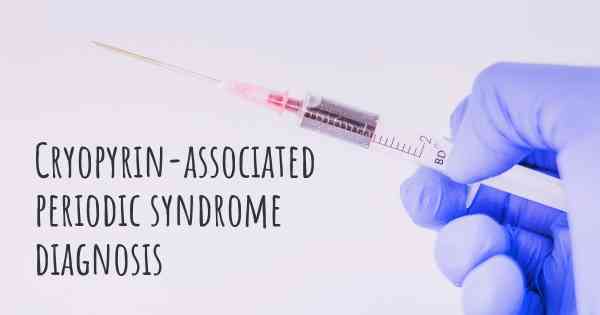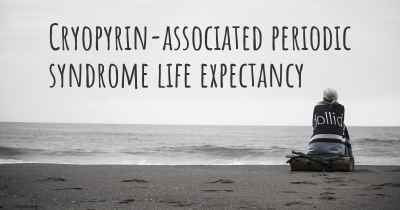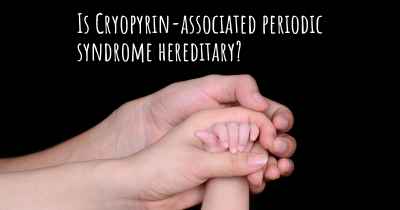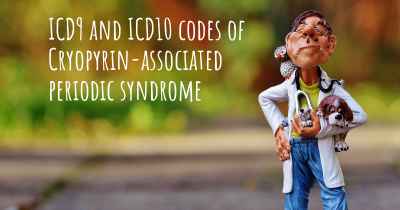How is Cryopyrin-associated periodic syndrome diagnosed?
See how Cryopyrin-associated periodic syndrome is diagnosed. Which specialists are essential to meet, what tests are needed and other useful information for the diagnosis of Cryopyrin-associated periodic syndrome

How is Cryopyrin-associated periodic syndrome diagnosed?
Cryopyrin-associated periodic syndrome (CAPS) is a rare autoinflammatory disorder characterized by recurrent episodes of fever, rash, joint pain, and other systemic symptoms. It is caused by mutations in the NLRP3 gene, which leads to overproduction of a protein called cryopyrin. CAPS encompasses a spectrum of diseases, including familial cold autoinflammatory syndrome (FCAS), Muckle-Wells syndrome (MWS), and neonatal-onset multisystem inflammatory disease (NOMID) or chronic infantile neurologic cutaneous articular syndrome (CINCA).
Diagnosing CAPS can be challenging due to its rarity and overlapping symptoms with other conditions. However, a combination of clinical evaluation, genetic testing, and laboratory investigations can help in reaching an accurate diagnosis.
Clinical Evaluation:
The first step in diagnosing CAPS involves a thorough clinical evaluation by a healthcare professional. The doctor will review the patient's medical history, including symptoms, family history, and previous episodes. They will also perform a physical examination to assess the presence of characteristic signs such as rash, joint swelling, and fever. The doctor may ask specific questions related to the timing, duration, and severity of symptoms to differentiate CAPS from other conditions.
Genetic Testing:
Genetic testing plays a crucial role in confirming the diagnosis of CAPS. It involves analyzing the patient's DNA for mutations in the NLRP3 gene. This can be done through various methods, including targeted gene sequencing, whole-exome sequencing, or specific mutation analysis. Identifying a pathogenic mutation in the NLRP3 gene is highly indicative of CAPS. However, it is important to note that not all patients with CAPS will have detectable mutations, especially in cases of somatic mosaicism or genetic variants that are not yet identified.
Laboratory Investigations:
Laboratory tests are essential to support the diagnosis of CAPS and rule out other possible causes of symptoms. These tests may include:
- Acute-phase reactants: Blood tests to measure markers of inflammation, such as C-reactive protein (CRP) and erythrocyte sedimentation rate (ESR). Elevated levels of these markers during episodes of symptoms can indicate CAPS.
- Complete blood count (CBC): This test helps evaluate the presence of anemia, leukocytosis, or other blood abnormalities that may be associated with CAPS.
- Urinalysis: Examination of urine for the presence of protein, blood, or other abnormalities that may suggest kidney involvement, which can occur in some forms of CAPS.
- Immunoglobulin E (IgE) levels: Measurement of IgE antibodies in the blood, which can be elevated in certain subtypes of CAPS.
- Other biomarkers: Additional tests may be performed to assess specific organ involvement or to monitor disease activity. These can include imaging studies, joint fluid analysis, or specific biomarkers like serum amyloid A (SAA) or interleukin-1 beta (IL-1β).
Differential Diagnosis:
Since CAPS shares symptoms with other autoinflammatory and autoimmune disorders, it is important to consider differential diagnoses. Conditions that may resemble CAPS include systemic juvenile idiopathic arthritis (sJIA), adult-onset Still's disease, systemic lupus erythematosus (SLE), and other periodic fever syndromes. The clinical evaluation, genetic testing, and laboratory investigations help differentiate CAPS from these conditions.
Conclusion:
Diagnosing Cryopyrin-associated periodic syndrome (CAPS) involves a comprehensive approach that combines clinical evaluation, genetic testing, and laboratory investigations. The clinical evaluation helps identify characteristic signs and symptoms, while genetic testing confirms the presence of mutations in the NLRP3 gene. Laboratory investigations, including acute-phase reactants, CBC, urinalysis, and specific biomarkers, support the diagnosis and rule out other possible causes. Differential diagnosis is crucial to differentiate CAPS from similar conditions. Early and accurate diagnosis is essential for appropriate management and treatment of CAPS.








